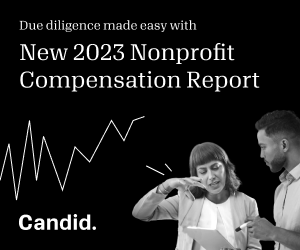The essential role of public-private partnerships in future building

There is no single ideal future for everyone. Some imagine AI and other advanced technologies making our lives more efficient; others envision an end to wicked problems like food insecurity and homelessness, while still others focus on addressing environmental threats like climate change.
To reach those futures, we ought to reimagine public-private partnerships and activate a new model of working together as change agents for future building. With their deep knowledge and connections within the communities they serve, nonprofits joining forces with both public and private organizations can be a potent source for sustainable social good at scale.
Forget what you know about past public-private partnerships (PPPs). The model of bankers and lawyers joining forces to reach a deal to construct, for example, a one-off infrastructure project such as a dam or hospital, has now evolved to include a broader, more holistic mandate enlisting nonprofit organizations, foundations, universities, small businesses, corporations, and governments to build a coalition.
The brutal truth is that we face an increasingly dire future if we’re unable to pull together our collective assets, expertise, and capacity. Adding to the evolving, rapid state of technology and digital transformation, no one group has the resources, authority, and talent to tackle it alone. Everyone has a role to play, especially nonprofits.
New models of public-private partnerships
No one can build the future alone. By partnering with nonprofits, private groups and public organizations alike can make an even more valuable impact in their fight for the greater good, combining the unique strengths and advantages of each type of organization.
Future-oriented nonprofits and grassroots organizations are invaluable in proposing potential solutions when it comes to community input and buy-in. Government agencies, on their end, provide regulatory framework, resource mobilization, and long-term engagement among a long list of benefits. Lastly, companies large and small can provide funding, research capability, access to opportunities, and more.
We all have an opportunity now to mold what the next generation of public-private partnerships will look like. The new model of public-private partnerships will develop a series of ongoing, human-centered, civic and social infrastructures and relationships that support the generation of growth and prosperity for a community. It is less of a transactional model and more focused on long-term relationship building for impact.
A prime example is the Centre for Public Impact, a global nonprofit founded by the Boston Consulting Group. They aim to improve the government’s ability to tackle today’s complex problems. They have partnered with the City of Portland’s Office of Community and Civic Life on equity centered community engagement, and have co-hosted Demo Days with local governments, Google.org, and community organizations to design new local data-driven applications.
Another example is the organization I lead as founding executive director, the Partnership for Inclusive Innovation. We work to democratize innovation by increasing partnership opportunities for researchers, nonprofits, entrepreneurs, students, and communities to scale and activate projects on the ground. C-suite leaders from corporations such as Inspire Brands, Cox, Synovus, Equifax, Invesco, and Southern Company join civic and government leaders from Georgia Tech, the University of Georgia, the Georgia Municipal Association, the Georgia Department of Community Affairs, and the Federal Reserve Bank of Atlanta to pool financial and social capital for long-term investments in the community.
We aim to catalyze innovation for shared economic prosperity through our current portfolio of 62 projects across 121 project sites in all 12 of Georgia’s economic development districts. But our work goes beyond the state of Georgia. We have worked with 25 institutes of higher learning and 29 local governments. The projects have supported almost 200 entrepreneurs and small businesses and secured millions of additional dollars—from supporting agricultural technology advances to reducing energy poverty and offering students experiential learning in public innovation and civic technology.
One example is a team that consist of the nonprofit Focused Community Strategies, the City of Atlanta, Morehouse School of Medicine, and Georgia Tech. They are actively working to address neighborhood energy poverty with technology and research, human-centric design, and stakeholder engagement. Projects like these exemplify the synthesis between nonprofits, for-profits, and government working together to create new initiatives oriented toward disrupting a poor status quo for a better way forward.
The role of nonprofits with the rise of purpose-driven capitalism
While companies’ participation in any successful PPP is essential, nonprofits are uniquely positioned to bring a wide array of benefits:
1. Commitment: Nonprofits are born out of a strong commitment to social or environmental causes. They bring a mission-driven approach that prioritizes public welfare, community development, or addressing specific societal needs that is unparalleled.
2. Advocacy and representation: Nonprofits serve as advocates for underrepresented communities. They bring the perspectives and interests of these communities to PPPs, ensuring that their voices are heard and their needs are addressed. This helps promote equity, inclusivity, and social justice in partnerships’ overall decision-making processes.
3. Accountability and transparency: Nonprofits’ commitment to transparency and accountability enhances public trust and confidence in PPP projects.
4. Flexibility and innovation: Nonprofits are often nimble and adaptable, capable of responding to emerging needs and experimenting with innovative solutions. They bring a spirit of creativity, which can foster new approaches, pilot projects, and alternative service delivery models. This flexibility can lead to more agile and responsive solutions within the new PPP.
5. Workforce opportunities: Nonprofits capture the future of work with the younger generations who seek to work in a mission-driven organizations. They provide a healthy complement to older generations with more intergenerational innovations and collaborations under PPPs.
When nonprofits partner with public institutions and private companies to solve seemingly intractable challenges, good things—and often great things—result. And that is a future we can all work toward together.
Debra Lam is founding executive director of the Partnership for Inclusive Innovation.








Three lessons for philanthropy in addressing systemic racism in health care